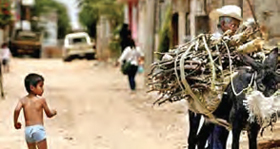
CORPORATE CITIZEN CLAPS FOR MADURAI FARMER M SEEDHURAMU, HIS CO-TILLERS, AND THE DHAN (DEVELOPMENT OF HUMANE ACTION) FOUNDATION FOR REVIVING THE DYING 9-ACRE WIDE KAATHIYANOOR IRRIGATION TANK, WHICH NOW IRRIGATES 50 ACRES OF FARMLAND

Turn to 2016, when climate crisis and urban infrastructure threatened cultivation around Iravadhanallur, some 6 km away from Madurai. The brunt of public-private infrastructure reduced common wastelands and catchment areas. Subsequently, the reduced water flow diminished the harvesting potential of the nearby Kaathiyanoor tank, spread across 38 acres. Unregulated sand mining along the riverbed and the low flow in the neighbouring Vaigai river also proved detrimental to paddy cultivation. The ensuing crop losses due to water scarcity dented a large part of the farmer’s savings. With the intervention of DHAN, Seedhuramu and his friends Kumaresan, a retired postmaster, and Alagusundaram formed a farmer’s trust. Thus began their 3-years arduous journey to channelise water for irrigation around the tank. They collected Rs 75,000 from the affected farmers, deepened the Kaathiyanoor channel up to 1 meter to link with the nearby Chottaithatti canal, and constructed a boundary wall around the tank. However, the inflow of sewage from the canal resulted in the tank getting dirty water. They used the local Canna Indica plant to desilt the water in a natural, organic manner. However, their indigenous project failed and covered the deepened area with silt. They then approached DHAN, which studied the history, rainfall patterns, crop yields, and waste disposal habits of the region. “The 2-km long stretch of the canal from the border of Iravadhanallur till the tank was widened to 14 feet enabling water to flow freely. They also removed the water hyacinth that clogged the flow. Once desilted, the groundwater quality in the locality also improved. The farmers renewed paddy cultivation after a 5-year gap, and the resultant ecological change also brought back sparrows, cranes, and ducks to the region. A concerted effort by local farmers, government, and corporates met the considerable project cost challenge. Sedhuramu said, “It cost us Rs 20 lakh, out of which Rs 18 lakh came from a few other corporates while Rs 2 lakh was raised by the locals.” The project symbolises that a firm ‘will’ can revive an entire ecosystem from ‘toil’ to ‘till’!
CORPORATE CITIZEN SLAPS THE POOR QUALITY OF LIFE (QOL) AMONGST INDIAN ADULTS, ESPECIALLY MORE WOMEN (50.4%) THAN MEN (42 %), AS INDICATED IN A JOINT STUDY BY DANONE INDIA AND THE CONFEDERATION OF INDIAN INDUSTRY (CII)
 Poor quality of life in India revealed
Poor quality of life in India revealed
It was revealed that 46.2% of Indians lead a poor QoL. The study covered the quality of life amongst 2,700 plus adults in India and observed that on a city-wise breakup, Kolkata recorded the highest percentage of adults (65 %) with a poor QoL score. Mumbai, scored as the city with the best quality of life percentage of adults (68 %). While the pandemic encouraged most to prioritise health, the situation continues to be grim for many across the country. Chennai ranked second with its poor QoL at 49.8 %, followed by Delhi (48.5 %), Patna (46.2 %), Hyderabad (44.4 %), Lucknow (40 %) and Indore (39.2 %). Almost 99 % of the respondents across India agreed that physical health and nutrition are important for a good QoL. While nearly 98 % of the study population opined that a protein-rich diet is essential for a good QoL, only 9 % of the respondents fulfilled their protein requirement (recommended dietary allowance). As per the study, the gap in protein intake across the country was related to the intake of 10 micronutrients that are important for immune function and overall health. The findings stated that a higher percentage of the older age group had poor quality of life than the younger age groups; which also correlated gender, age, socio-economic and work status on the overall quality. QoL was highest for those employed, followed by self-employed, housewives, and the unemployed population remained at the ‘bottom’ viz. their QoL. Vinita Bali, Chairperson, CII, said that the findings had indicated the gap in nutrition, even amongst the upper-income groups in cities. “This can only be tackled by taking personal responsibility for the choices we make as consumers and, on the supply side, by making nutritious food more available, accessible, and affordable,” she said.